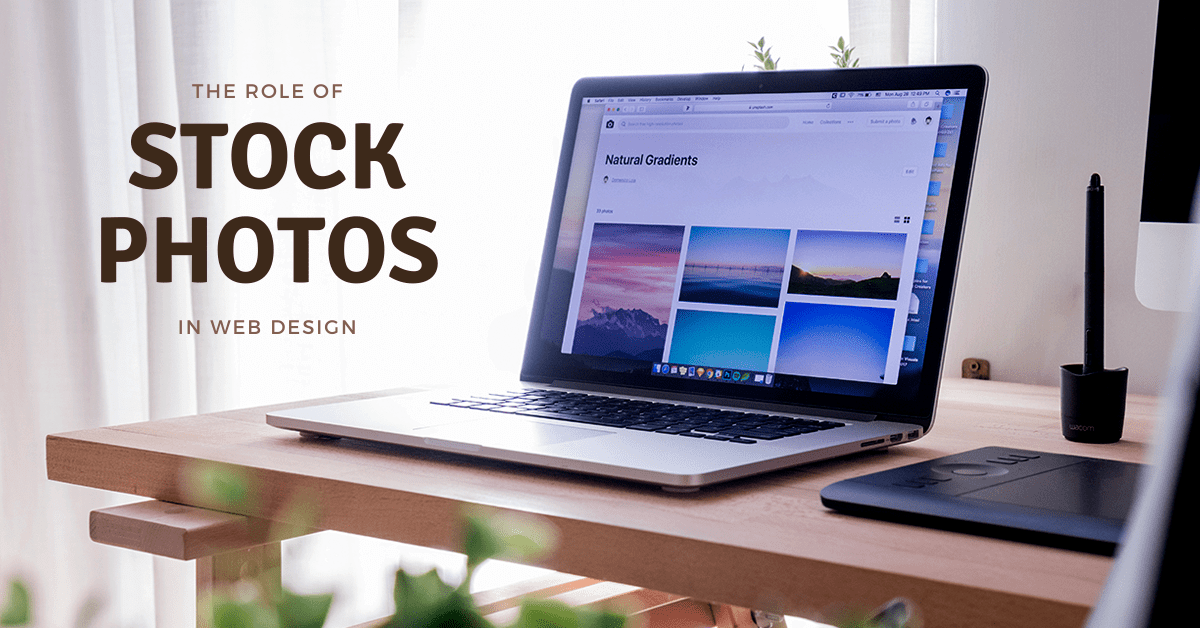
In the digital era, websites serve as the virtual storefronts for businesses and individuals alike. A crucial aspect of web design is the visual content, which often includes the use of stock photos. These readily available images can enhance a website’s appeal, but they also come with certain considerations. This article delves into the rationale behind using stock photos, outlining their pros and cons of using stock photos in websites and the web design process.

What Are Stock Photos?
Stock photos are professionally taken photographs that are available for purchase or free use on various online platforms. These images cover a wide range of subjects and styles, making them a versatile choice for website imagery.

Pros of Using Stock Photos in Websites
1. Cost-Effectiveness
Stock photos represent a cost-effective solution for sourcing high-quality imagery, especially when compared to the expenses involved in hiring a professional photographer. Professional photography can be prohibitively expensive, involving not just the photographer’s fees but also the costs associated with models, locations, equipment, and post-production. In contrast, stock photos offer a vast array of choices at a fraction of the cost.
For small businesses, startups, or individuals with limited budgets, stock photos are a financial lifeline. They provide access to professional-grade photographs without the high price tag. Even premium stock photo websites offer packages or subscription models that allow users to download multiple images at a reduced rate, further enhancing their cost-effectiveness. This affordability also extends to variety; users can access numerous images for the same price as a single session with a professional photographer, offering greater flexibility in visual content without a substantial financial investment.
Moreover, stock photos reduce the need for costly and time-consuming reshoots. In traditional photography, if the output doesn’t meet expectations, it may necessitate additional shoots, further escalating costs. Stock photo libraries, on the other hand, offer the opportunity to preview and select exactly what is needed, ensuring that the final selection aligns perfectly with the user’s requirements without incurring extra expenses.
2. Time-Saving
The time-saving aspect of using stock photos is a significant advantage, especially in a fast-paced digital world where speed is often of the essence. Organising a professional photo shoot is a time-intensive process. It involves various stages including planning, hiring photographers and models, setting up the location, conducting the shoot, and post-processing the images. This process can take days, if not weeks, to complete.
Stock photo websites, in contrast, offer immediate access to millions of images with just a few clicks. This instant availability is crucial for meeting tight deadlines and is particularly beneficial for content creators who need to publish regularly and on short notice. The search functionality on these platforms is sophisticated, enabling users to find specific types of images quickly using keywords, categories, filters, and even colour schemes.
This time efficiency extends to the versatility of the images available. With a vast library at one’s disposal, it’s possible to find photos for a wide range of topics and themes, eliminating the need for multiple, time-consuming photo shoots. For businesses and individuals who need to update their website or social media content regularly, this immediate access to a diverse range of images is invaluable.
3. Professional Quality
The professional quality of stock photos is a primary reason for their popularity. These images are taken by skilled photographers who understand the nuances of lighting, composition, and subject matter, ensuring that each photo is of a high standard. The quality of these photos is often equivalent to, or even surpasses, what might be achievable through individual photo shoots, especially for those without access to professional photography resources.
Stock photos are typically available in high resolution, which is essential for modern web design and printing purposes. They need to look good on various devices, from large desktop monitors to smartphones, and high-resolution images ensure clarity and sharpness across all platforms. Moreover, these photos are often professionally edited and retouched, presenting the best possible version of the subject matter.
The range of styles and subjects in stock photography also contributes to their professional quality. Whether you need images for a corporate website, a creative project, a blog, or marketing materials, there is a vast array of professionally styled and themed photos to choose from. This variety allows users to maintain a high level of professionalism in their visual content, regardless of their specific industry or niche.
4. Diverse Choices
The diversity of choices available in stock photo libraries is unparalleled. These platforms host millions of images, covering virtually every conceivable topic, theme, and style. This vast selection allows users to find the perfect image for any context, be it for a website, advertisement, blog post, or any other visual content needed.
This diversity extends beyond just subjects and themes; it includes a range of photographic styles and compositions. From traditional and conservative images to modern and abstract styles, stock photo libraries cater to a broad spectrum of aesthetic preferences. This variety is particularly beneficial for businesses and creatives who need to adhere to specific branding guidelines or who wish to explore different visual narratives.
Furthermore, the global nature of stock photo libraries means that users have access to images from around the world, offering cultural diversity that might be difficult to capture otherwise. This global perspective is crucial for businesses and websites that cater to an international audience, as it allows them to represent and connect with a broader demographic.
In addition, new images are constantly being added to these libraries, ensuring that the available content is up-to-date with current trends, events, and technologies. This continuous influx of new material keeps the options fresh and relevant, providing users with a perpetual source of contemporary imagery.

Cons of Using Stock Photos in Websites
1. Lack of Originality
The use of stock photos often leads to a lack of originality in web design. These images, available to anyone with internet access, can result in a homogenised visual experience across multiple websites. This is particularly problematic for brands striving to establish a unique identity in a crowded digital marketplace. When a website uses popular stock images, it risks blending in with countless others, diluting its distinctiveness and brand recall.
Originality in imagery is not just about standing out visually; it’s also about conveying a message that resonates specifically with your target audience. Custom photography allows for the creation of visuals that are tailored to reflect a brand’s unique values, ethos, and personality. This specificity is often missing in stock photos, which are designed to be broadly appealing and generic. This generic nature might lead to a disconnect between the brand’s message and the imagery used, weakening the overall impact of the website.
Moreover, repeated exposure to the same stock images can lead to visual fatigue among viewers. When consumers recognize an image from multiple sources, it may lead to negative perceptions, such as questioning the professionalism or authenticity of the brand. In industries where differentiation is key to success, reliance on stock photos can be a significant disadvantage. Thus, while stock photos are a convenient option, they come with the risk of making a website feel less personalised and impactful.
2. Limited Customization
Stock photos, while diverse in their range, offer limited customization, which can be a significant drawback for businesses seeking to align their website imagery closely with their brand identity. When you choose a stock photo, you are selecting from a pre-existing pool of images that were not created with your specific brand, message, or audience in mind. This limitation can lead to a mismatch between the visual narrative of your website and the unique story your brand aims to tell.
Customization is not just about the subject of the photo; it’s about capturing the essence, tone, and values of the brand. Stock photos might not accurately represent the demographic diversity of your audience or the specific context of your products or services. For instance, a health care provider might struggle to find stock photos that genuinely reflect the warmth and personalised care they offer, or a tech company might find it challenging to locate images that precisely represent their cutting-edge innovations.
Another aspect of customization is the ability to control every aspect of the image – from the setting and lighting to the expressions and poses of the subjects. This level of control is crucial when trying to create an emotional connection with your audience. Stock photos, being generic, often lack the emotional depth and nuanced storytelling that custom photography can provide.
In essence, while stock photos can fill gaps quickly and efficiently, they fall short when it comes to tailoring the visual experience to align seamlessly with a brand’s unique identity, often resulting in a less engaging and persuasive website.
3. Perception Issues
The perception of stock photos by website visitors can be a significant concern. Often, stock images are perceived as inauthentic or overly staged, which can detract from a website’s credibility. This is particularly crucial for brands that rely on authenticity and trust as core components of their identity. In sectors like healthcare, education, or non-profit organisations, where trust and relatability are paramount, the use of generic stock photos can create a disconnect with the audience.
The staged nature of many stock photos can also lead to a lack of emotional resonance with viewers. These images are usually designed to be as broadly appealing as possible, which often results in them lacking the specific emotional cues that resonate with a particular audience. For example, a stock photo used on a counselling service’s website might fail to convey the genuine empathy and warmth that are crucial to the service’s value proposition.
Moreover, certain stock photos have become clichés due to their overuse, leading to a negative perception. Images like the ubiquitous “corporate handshake” or “customer service representative with headset” can come across as insincere and may even be mocked by more discerning audiences. This can lead to a reduction in engagement and a weaker connection with the website’s content.
In a digital landscape where consumers are increasingly seeking authenticity and personal connection, the use of stock photos can be counterproductive. It’s essential for brands to carefully consider how these images might be perceived and whether they align with the desired brand image and values.

Striking a Balance
To effectively use stock photos, it’s important to balance their convenience with the need for originality and brand alignment. Custom photography can be mixed with stock images for a unique blend, and choosing less common stock photos can help maintain a distinctive look.
Conclusion
Stock photos offer a practical solution for adding visual elements to a website, but they come with both benefits and drawbacks. Understanding these aspects allows web designers and business owners to make informed decisions that best suit their website’s needs and goals.
Whether you’re aiming for a custom-designed website or just a basic template website, applying the correct photo strategy is crucial for achieving the right brand positioning. At WDD Malaysia, we provide specialised consulting sessions to help you select the best photos and images for each section of your website. Our expertise ensures that your website not only looks appealing but also aligns perfectly with your brand identity.
If your website needs a revamp or if you’re starting a new project, don’t hesitate to contact us. We’re here to assist you in making your website visually striking and effective. Reach out to WDD Malaysia at any time for professional guidance and support in elevating your online presence.




